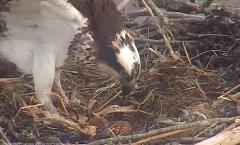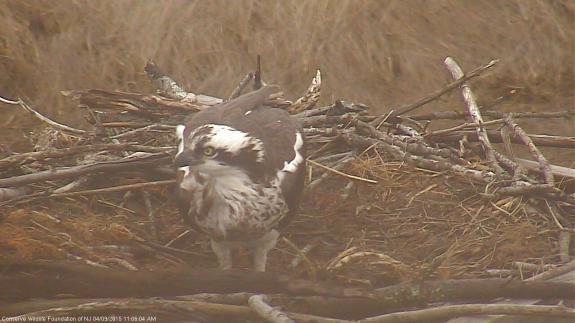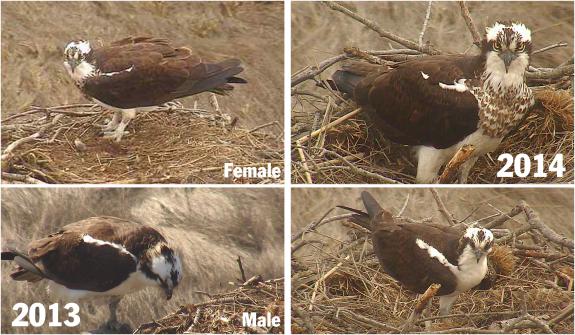2015 Nest Cam News
News and insight from the third season of the Forsythe NWR Osprey Cam.
October 1
Camera will be offline until further notice. Please contact Ben if you have any questions. Donations are much appreciated!
September 1
Off they go! As our nesting ospreys disperse and head south to even warmer climates, we settle in with the fact that winter is coming... At the Osprey Cam nest here we've been watching for the female and she is gone. Along with two of her offspring (the oldest). The youngest appears to be content with begging for food from the male. He should take to the skies sometime this month. With the dome of high pressure over the mid-west most migration along the Atlantic flyway has stalled. Once we get a cold front to pass through then more birds will ride the thermals south on the NW winds. For now, we get to watch the last glimpses of ospreys, our birds of summer.
As ospreys leave we begin to make plans for repairs and maintenance to nesting platforms. We've got quite a list of work to do and we'll be sure to share when we plan to do this work and where to get some volunteers engaged in our work. To get notifed of future volunteer ops, please email Ben Wurst.
August 4
Now that all young have fledged (and we got to watch!) they are becoming less and less reliant on the adults and the nest. For now, they are still eating fish that the adults catch but are feeding themselves. Soon they'll start to disperse locally before migrating south in September. The adult females are known to start migrating in late August followed by the males and juveniles. You can track juvenile and adult ospreys on migration using GPS transmitters.
Now we are starting to think about fall maintenance at the cam. First we'll be proposing to move the camera to the nest platform. Then we'll be beefing up the solar array pole and changing out the batteries. For a period this fall we may not be broadcasting. Stay tuned for updates!
July 28
 An osprey fledgling sits on the nest.
An osprey fledgling sits on the nest.  Another fledgling preening on the solar panel array.
Another fledgling preening on the solar panel array.
Well, I know when I get concerned viewers emails that no birds are on the nest that they young have all fledged! At this time of year it is not uncommon to see no young or more than three young perched on the nest. This is a sure sign that all young have fledged. You can read about the exact date on our Interactive Osprey Cam page, where dedicated viewers can watch, post comments and ask questions.
Now the young are all learning the skills they need in life to survive. They're beginning to soar, hover, and most importantly: GO FISHING! Surely many of their first attempts to catch a fish will be missed, but as they say, practice makes perfect. The adults are known to show the young where to go to find fish, like at the beach where large schools of bunker can be found at this time of year. It's a great time to get outside and watch some ospreys! They are practically everywhere along the coast before they start migration later next month. Look up for large kettles of them as they ride on thermals. It's a really cool sight!
July 14
Time sure does fly, and ospreys sure do develop quickly! From my last update, on June 17, we announced our plans to band the young. Since then the young have doubled in size and age and are now 7 weeks old. Already they can be seen flapping and jumping to strengthen their wing muscles in preparation for their first flight. At this time of their development it is too late to try to band the young. I'm sure everyone would like to watch and learn, but we missed our window of opportunity while conducting other nesting surveys throughout southern New Jersey. At those areas we did not know how many young were produced and needed to collect this valuable information to assess the health of the state population. We still need to survey one important nesting colony.
Banding young is our secondary goal when conducting osprey nesting surveys. Since we know how many young were produced at this nest, there is no need to walk out to the nest (which is difficult). The same can be said for the other nests at Forsythe NWR. Many photographers watch those nests, so we can get information on how many young were produced from them. In addition, at six weeks in age, a nestling could jump from the nest prematurely and we do not want to cause that to happen!
We just hope that our camera system stays online this summer so we can watch all young fledge successfully! We are making plans to replace the batteries in the system this fall.
June 17
The young ospreys are now 21 days old. At this point in their development all of their contour feathers have emerged from their protective sheaths. You'll notice that much of the time they are resting or eating, with a little preening in between. The young can now keep themselves warm but the adult female often shades them to keep them cool. The adult male is often away from the nest while searching for and catching prey. This is his busiest time of year. He's got four hungry mouths to feed. A brood of three young requires at least 6 lbs. of fresh fish every day until after the young fledge and are able to catch and eat their own prey.
They are now a bandable size. Each summer specially trained volunteers and biologists start to conduct nesting surveys in the most densely populated colonies throughout NJ. This nest and others at Forsythe NWR will be banded next Thursday, June 25th, starting around 3:30pm with this nest. The banding will be streamed online. I'll be trying to "live tweet" during the banding on our Twitter to answer any questions. -Ben
June 10
 The oldest young are 14 days old.
The oldest young are 14 days old.
At 14 days old, the young ospreys begin to move all around the nest. Their eyesight is better and they explore their nest. The adults continue to brood, as needed, on cool days and shade them on hot days (more shading is typical as the weather warms and they grow quickly). The youngest is 12 days old and you can clearly see who the runt is. The body, or contour feathers on the oldest young are just starting to emerge. In the coming days you'll see a pronouned white stripe of downy feathers appear on the young. Their plumage is very crypticly colored and this gives them good protection from any avian predators. If any threats come close then the adults call loudly to warn the young and then instinctually lay down and play dead.
 Zoom+ 7-10 day old ospreys playing dead.
Zoom+ 7-10 day old ospreys playing dead.
Young ospreys are banded at the age of 21-32 days before they can fly and leave the nest. In two weeks several dedicated volunteers and biologists will conduct nesting surveys for ospreys throughout the most densely populated colonies in NJ. In short, these "osprey banders" record the number of active nests and count the number of young produced. The data collected will help determine the overall health of the population in NJ.
May 28
 Three hatchlings being fed on 5/28/15. We lost connection with the camera yesterday but it magically came back online this moring. The third egg must of hatched early this morning.
Three hatchlings being fed on 5/28/15. We lost connection with the camera yesterday but it magically came back online this moring. The third egg must of hatched early this morning.
Well, we had a bit of a scare yesterday. Not in the form of anything osprey, but more in the form of everything technically related to the camera! The whole system never came online yesterday morning. We could not log on to the camera remotely and after visiting Forsythe NWR to diagnose, we could not find it on the local network either. All technicalities aside, that meant that the problem was out at the nest. We faced a question of whether to go out to quickly fix it or wait. With hatchlings we knew the best action (despite getting backlash from disappointed viewers) would be to wait until the young were old enough to band, at 21-28 days old.
But, today we awoke to a great sight (at least I know I did)! I brought up the feed on my iPhone and it was connected! Yay! The other great sight was that viewers now saw three hatchlings...awesome!
May 26
 Two eggs hatched overnight on May 26, day 40 of incubation. One egg left to hatch...
Two eggs hatched overnight on May 26, day 40 of incubation. One egg left to hatch...
Two chicks!! When the camera came online this morning we got to see two hatchlings! The male is there already with a flounder. Today is day 40, so these eggs hatched right on schedule. In 2013 the first egg hatched on day 39 and in 2014 the first egg hatched on day 40. We should see the third eggs hatch in the next two days.
May 18
 Day 32 of incubation. When do you think the first egg will hatch?
Day 32 of incubation. When do you think the first egg will hatch?
Sorry for my lack of updates! It's a least good sign that it's business as usual: incubation. Today marks day 32 from when the first egg was laid on April 16th. Ospreys exhibit asyncronous hatching, so the eggs hatch in the order they are laid. The range for incubation in osprey eggs is from 32-43 days. The average in NJ is around 36 days. Hatch watch begins this week!
April 27
 Zoom+ Three eggs are clearly visible in the nest bowl!
Zoom+ Three eggs are clearly visible in the nest bowl!
And then there were three! The third egg was laid on April 25 (Earth Day). Incubation averages around 35 days in NJ. Last year it lasted a total of 40 days though. With cooler temperatures this spring we might also see a delayed hatch date of the first egg. Hatch watch starts on May 22 (day 35). During incubation you'll notice that the female does the majority of the incubation while the male does all of the foraging. After a successful hunt he almost always feeds himself first (away from the nest) and then offers food to the female. If we had sound that worked then we might hear the female begging for food while the male mantles his catch. Mantling is where the male is reluctant to share his food with his mate. It's often seen in young pairs. You can read more about this behavior on my good friend's blog. He flies to their nest and transfers the prey to her and she flies to a nearby perch to feed. Their diet varies throughout the season. Main prey items in NJ include: bunker or menhaden, flouder/fluke, with occasional striped bass, bluefish, trout, freshwater bass and whatever else is an easy catch! What have you seen them catch? Join the convo. on our interaction page!
April 21
Quick update: Pair is now on two eggs! First was laid on April 16 ~ 4:45pm. Then the second egg was laid on April 19 ~ 5:00pm. If we're lucky we might see the third egg today!
Ospreys exhibit asynchronous hatching, so they start incubating when the first egg is laid. This is a natural adaptation that allows the oldest and strongest nestling to survive when the availability of prey is low.
The average incubation period for NJ is 36 days (it varies from only 32 days to 43). We should see hatching during the third week of May.
April 9
 Looks like she's got a full crop!
Looks like she's got a full crop!
As far as we know, it appears that the birds are the same as last year. When we get some good, calm weather with both birds on the nest I'll get some high res. photos to compare to the previous two years. The have been seen copulating over the past several days on the nest. The male has been slowly adding nesting material, which is mostly collected from within view of the nest. The poor conditions of the past few days have been rough. Strong winds, rain and cloudy conditions make for poor visibility for fishing. But, trout have been stocked throughout the state and bunker are schooling off the coast.
Last year the first egg was laid on April 19. They arrived back earlier this year, so that might indicate that the female will lay slightly sooner. My bet is on egg laying to occur on April 14! :)
March 31
Today, with help from a bunch of great volunteers, we dropped the osprey cam pole and replaced the old IR light. Before walking out to the nest I saw the male performing courtship displays over the nest for the female. The female was perched on the nest when we walked out there. She flew off peacefully and perched in a nearby tree. Everything else with the camera looked good. We removed the audio components to save power for the camera and fix what has caused them to not work since the beginning..
The pair will continue to work on the nest and strengthen their pair bond. Eggs are usually laid in mid-April.
Thank you to the guys to who helped me out today, Bob, Dave, Tim and Kyle and for those who donated to support the Osprey Cam. Thanks! --Ben
March 25
Both birds are back! Female arrived on March 19th and male showed up yesterday, March 24. Both birds returned earlier this year. I'm not sure why. Weather has been unseasonably cool since the start of the year. Hopefully things will warm up soon!
I haven't gotten a good look at the male, but so far it appears that both are the same as last year.
March 12
I've seen some reports of some early spring osprey migrants. Usually some start to show up at nests along the D. Bay, specifically the Maurice River at this time of March. Usually they arrive a bit later on the Atlantic Coast. Days with south winds help push spring migrants north. Each and every day will be bringing more migratory birds north.
In the meantime, we have work to do. Currently the infrared light is not working properly. It has power but at night, we have no IR light...We have found out that getting an advanced replacement is not an option, so we're walking on eggshells to try and find a replacement unit asap. The sound is still another issue. We have re-wired the microphone two times already and still get some kind of interference/white noise. We hope to try and diagnose this when we go out one last time in the next 2 weeks to do any last minute work.
February 3, 2015
 Comparison between the adult ospreys that nest at the Osprey Cam. Both are unbanded.
Comparison between the adult ospreys that nest at the Osprey Cam. Both are unbanded.
Welcome to another season for the Forsythe Osprey Cam! Over the next month we'll be conducting some maint. to the camera system which we hope will improve the viewing experience.
- The old network swtich will be replaced with a new unit that has a fan to keep the unit cool (since this is what we believe caused the camera to go offline last July).
- The microphone wire will be replaced (all we get is static right now) so hopefully sound will finally work for us this year!
- The IR light will be fixed.
- The camera lens housing will be cleaned.
Only 45 more days until Spring and when ospreys return to NJ! Last year the female returned on March 30 and the male on April 3.
Find Related Info: Osprey




